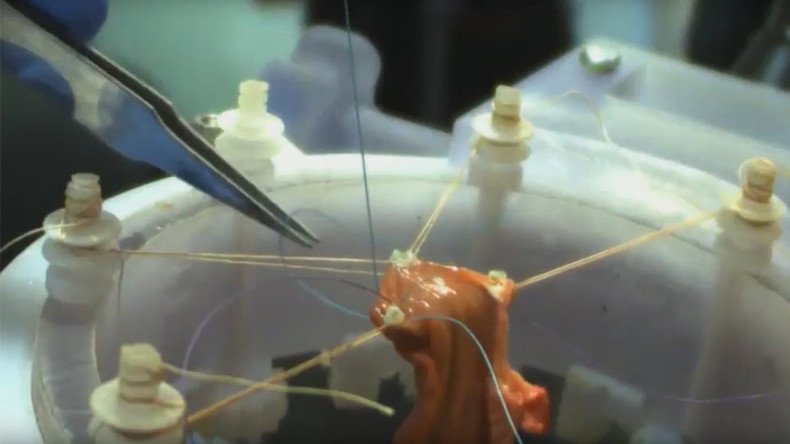Robot performs soft-tissue surgery without human operator

A new kind of robot has just reached a major milestone by suturing together segments of living pig intestine without a human operator. Its developers say that it can match or exceed human surgeons in precision and safety.
A new kind of robot has just reached a major milestone by suturing together segments of living pig intestine without a human operator. Its developers say that it can match or exceed human surgeons in precision and safety.
In a study published in Science Translational Medicine on Wednesday, researchers said that while their Smart Tissue Autonomous Robot (STAR) surgical bot is only a proof of concept, it could autonomously perform predictable but delicate and time-consuming procedures.
STAR is the invention of a team of computer scientists and medical researchers lead by Dr. Peter Kim of Children’s National Medical Center in Washington. Their machine just reached a major milestone in robotics by performing a procedure called intestinal anastomosis on a living, anesthetized pig, in which it sutured together two severed segments of intestine all by itself.
Equipped with an array of cameras and running a computer program that the team says is “inspired by the best human surgical practices,” the machine is able to see what it’s doing by tracking florescent dots injected into tissue, and then mapping the tissue onto a 3D model.
Such a procedure requires a great amount of consistency, said Ryan Decker, a research engineer on the project.
“Something that really helps me visualize it is if that the procedure is like trying to put together a garden hose, which has been cut. You want to have the spacing between sutures be very consistent and you want to have them to be tensioned very well and very consistently,” Decker told reporters.
Consistency is something that the machine proved it has an abundance of – it far outperformed human surgeons, including human surgeons that operate with the assistance of non-autonomous robots.
STAR does, however, require humans to supervise it, with tasks such as placing the fluorescent dots on the tissue making sure the threads don’t get tangled. It also lagged behind human surgeons in terms of speed, but this isn’t considered to be a problem by researchers.
“We can run the robot really, really fast. But in this study, we really focused on the outcomes, so we didn't run it as fast as we could,” Dr. Axel Krieger, a robotics expert and one of the team’s leaders, was quoted as saying.
READ MORE: Revolutionary ‘Da Vinci’ robot performs breakthrough micro-surgical treatment
Current robotic-assisted surgery systems, which took off at the beginning of the century, need to be directly operated by a human.
“Current robotic surgery is ‘teleoperated,’ [meaning that] every step and every movement of the robot, is directed by the surgeon,” Krieger told Popular Mechanics. “Our innovation is really to make this more autonomous, so that you don't have to direct every motion.”












